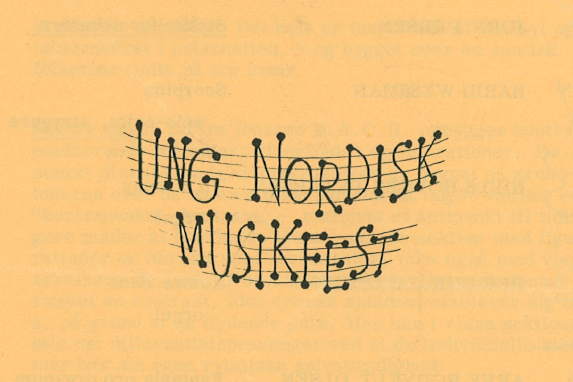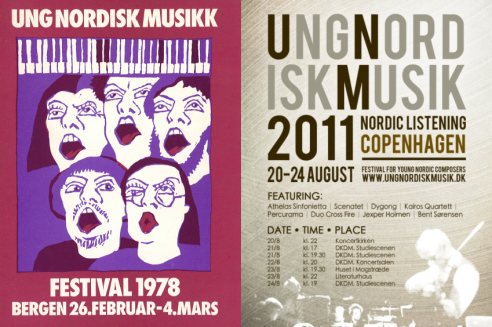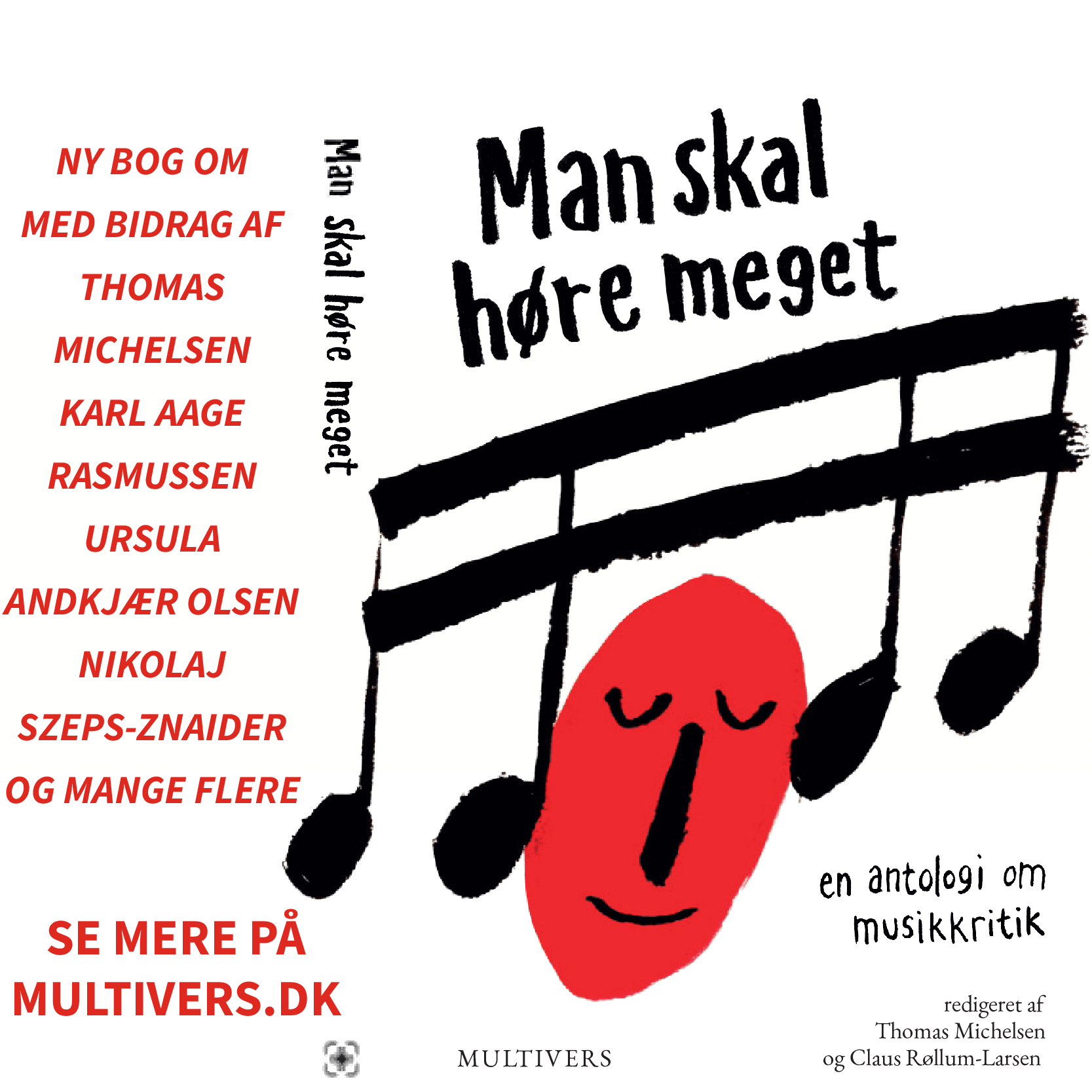
Hello, world – 70 years of Young Nordic Music
Per Nørgård stands in front of the message board, staring at a notice. He’s visiting the academy of music in Copenhagen sometime near the end of February 1964. Outside the thick walls a new society is emerging. The youth are seeking power, dismantling the authorities of an old world. Revolt is simmering; new winds are blowing in the streets. But not inside the academy.
“The student organization sends a heartfelt thanks to the two teachers showing up at our concerts!” Sarcasm drips from the notice, and Nørgård can’t stop staring at it. It confirms the disenchantment he himself had felt towards the conservative academy when he was enrolled there ten years earlier.
Earlier that month students hosted the 19th edition of what has begun to be known as Ung Nordisk Musik, literally Young Nordic Music, a youth-oriented version of the Nordic Music Days established in 1888. Swedish, Norwegian and Finnish colleagues gathered in Copenhagen during a period of six days to perform new music, but the academy director had not supported their efforts.
“The biggest disappointment of the festival has to be the academy’s attitude,” young composer Jens Wilhelm Pedersen (Fuzzy) writes in his review of the festival.1 The director of the academy, Knudåge Riisager, had turned down a request to suspend classes during the festival, but, as Nørgård states later on, “Two weeks after the festival all classes were suspended for several days – due to a meeting of academy directors!”2
A new beginning
A lot has happened since 1964. Young Nordic Music is celebrating its 70th anniversary; new music has been prevalent at the Nordic academies for decades; and earlier this year Per Nørgård received the Ernst von Siemens Musikpreis, one of the biggest accolades in the world of classical music.
Young Nordic Music has become an institution – one of the leading ones, too.
These days, Young Nordic Music is not about protesting against the lack of recognition for new music. Rather, it’s a testament to the importance of this festival for the participants’ artistic development. Young Nordic Music has become an institution – one of the leading ones, too.
As with many other modern stories about European culture, it begins in 1945. Europe is in ruins, the ashes drifting slowly from the rubble. Not only has the war brought massive destruction, it has also isolated citizens from each other and across borders. But May 1945 is a new beginning; the Nordic countries are once again free. Peace has barely settled on the country when a group of Copenhagen academy students contact their Nordic colleagues to instigate something new. On the 8th of October that year, representatives from Denmark, Sweden, Norway and Finland meet at Musikhögskolan in Stockholm to initiate an annual festival, the first edition to take place in Stockholm the very next year.
“The wave of cooperation sweeping through the awakened post-war world is a wonderful proof that the frost, although resilient, has spared the best seeds in the soil of the human mind.” The poetic phrasing is courtesy of Povl Ingerslev-Jensen, a former student during the 1920s at the academy in Copenhagen, who remembers all too well the unsupportive environment at the academy. The war was not the only agent of isolation. What a nice way to celebrate peace, by reaching out to your colleagues instead of regarding them as competitors. He proclaims his full approval of the new generation’s ambitions.3
 The roster of UNM 1968 in Aarhus.
The roster of UNM 1968 in Aarhus.
Something worth fighting for
There was no Wi-Fi in 1945. One of the aims of establishing Young Nordic Music was simply to be able to share scores and LP’s with each other. Academic libraries were still lacking when it came to 20th-century music, so composers and performers needed to get together to get an idea of international trends – new compositions were not readily available.
“It’s astonishing how little interest has been shown in the training of young composers."
“It’s astonishing how little interest has been shown in the training of young composers. While it’s possible to get a very decent education as an instrumentalist or theorist, there is, practically speaking, no education for composers,” writes Frede Schandorf Petersen, one of the Danish initiators of Young Nordic Music, in his 1947 report from the festival in Copenhagen.
“Now that the students have shown such vivid interest in and obvious talent for this hardly inconsiderable branch of the world of music, perhaps there’s a chance that something effective will be done to give this profession the kind of central position that it should occupy at the highest institution of musical education.”4 Two years later, composition is established as an independent study program at the Royal Danish Academy of Music, which is simultaneously turned into a public institution. Young Nordic Music has already achieved its first victory.
There is asymmetrical growth between the Nordic countries, however. Norway opens its first public academy of music in 1973, Norges musikkhøgskole, and the inequalities leave their mark on the first editions of the festival. For example, Oslo were to host the 1947 festival, but Copenhagen had to step in as hosts when the Norwegians cancelled three weeks before the opening. Likewise, contributions by the Danes and Swedes outnumbered their Nordic colleagues’ in the early years of the organization.
1974 is the first year in which Iceland takes part in the festival. And Young Nordic Music turns out to be a wake-up call to the secluded islanders: ”Middle-aged Icelandic composers still talk about the dizzying experience it was for the large Icelandic delegation to travel to Piteå in northern Sweden in 1974 and participate for the first time in the event,” Swedish musicologist Göran Bergendal later recounts.5
 UNM booklets: Oslo 1973, and Helsinki 1975.
UNM booklets: Oslo 1973, and Helsinki 1975.
Walking a tightrope
Camaraderie may have grown, but all was not a bed of roses. In a 1980 article titled “Men have to prove they CAN, we have to DISprove we CAN’T,” Anne Kirstine Nielsen criticizes the environment Young Nordic Music has helped to create.
By that time, the organization has grown so large and significant that those composers who are not present miss out on a significant networking experience. And that tends to be the case for women composers: “Women composers often start composing at a later age, which means they are denied access to the festival.”6 Since its inception, all participants must be under 30 years of age unless they are students.
Gender imbalance is not the only thing up for discussion during the past 70 years. The relationship between composers and musicians has also been an issue. At first, in 1945, Young Nordic Music placed its main focus on the working conditions of the composers. But of course the music must be performed, preferably well, and on several occasions the musicians have felt neglected. This became most evident at the 1981 festival in Copenhagen where a group of musicians protested because they were not paid for a concert broadcast on radio even though the composer received his royalties.7
The composers were quick to realize how important it is for the people performing their new music to share their enthusiasm about it.
However, since the 1970s, Young Nordic Music has attempted to establish more equal conditions for both musicians and composers, making sure that musicians also benefit from the festival program. The composers were quick to realize how important it is for the people performing their new music to share their enthusiasm about it.
The results are evident in the daily classes at the academies. As musicologist Søren Møller Sørensen writes in 1991: “Much that was previously considered impossible is taught these days at the academy!”8 And the most experienced participants at the festivals tell of substantial improvements in performance quality.
Window on the world
The earliest editions of Young Nordic Music festivals were focused on concerts, most often in the form of one concert for chamber music, one for orchestral music, and one for church and choral music. At the end of the 1960s, though, the focus and format changed. Lectures, workshops and many other events were included, and at the 1979 festival in Arvika, the concerts actually disappeared altogether. Instead, the Swedish organizers programmed numerous discussions, instrumental classes, morning gymnastics, and folk dance!
In 1980 the concerts came back. That year’s festival in Finland was, after all, organized by the likes of Esa-Pekka Salonen, later-to-be world-renowned conductor. Also amongst the organizers were Magnus Lindberg, in charge of booking rooms, and Kaija Saariaho, responsible for the festival booklet. The Finnish trio, who went on to establish great international careers, also had their stint at Young Nordic Music.
 Esa-Pekka Salonen, Kaija Saariaho, and Magnus Lindberg in festival booklets 1977 to 1981.
Esa-Pekka Salonen, Kaija Saariaho, and Magnus Lindberg in festival booklets 1977 to 1981.
While both the 1979 and the 1980 editions took place without inviting a famous figure from abroad – the organizers believe they’re perfectly able to moderate the debates themselves, and they want to experiment with the festival framework – the idea of inviting master composers from the rest of the world is one that has secured Young Nordic Music its reputation as a festival with an international scope.
“The most important discussions take place at the pubs after the concerts.”
For instance, at the festival in Aarhus, Denmark, in 1968, Mauricio Kagel introduces the participants to instrumental theatre, and ten years later Carnelius Cardew delivers an infamous speech in Bergen, Norway, about the role of the composer within class struggles, trying to convince the young artists that punk is an expression of fascism.9 A few years later, in 1981 in Copenhagen, Louis Andriessen concludes at the end of the festival: “The most important discussions take place at the pubs after the concerts.”10
Out of the isolation
Meeting your musical heroes can of course be very encouraging. However, it can also be paralyzing. When Per Nørgård and the rest of the participants of the 1954 Young Nordic Music festival in Helsinki take a field trip to the Sibelius residence in Ainola, Nørgård is too much in awe of the great Finn to shake his hand, even though they have recently exchanged their first correspondence in which Nørgård has expressed his appreciation of Sibelius’ music.
“Sibelius is standing on the porch, waving to the young Danish composers and wishing them the best of luck,” is how it is subsequently told in Dansk Musik Tidsskrift, the leading journal of new music in Denmark. “Amongst the young composers stands a shy Per Nørgård, afraid to make himself known. He won’t have the chance again; Sibelius dies on September 20th 1957.”11
“Young Nordic Music is and should be a festival for young, inexperienced composers, with young, inexperienced musicians, organized by young, inexperienced festival organizers.”
Sibelius chose to isolate himself in Ainola for the last 30 years of his life, without presenting another note to the public. Conversely, Young Nordic Music was created to help young composers out of the isolation created not only by the war, but also by the conservatism of the academies and the lack of camaraderie. Today, we witness a 70-year-old organization that has proven its worth and continues to function despite continual changes in the committees and the tendency toward chaos stemming from the lack of bureaucracy in the organization structure.
Participants seem to agree that such a structure is how things should remain. In the words of Danish composer Peter Bruun: “Young Nordic Music is and should be a festival for young, inexperienced composers, with young, inexperienced musicians, organized by young, inexperienced festival organizers.”12
 UNM 1978 booklet from Bergen, and UNM 2011 poster from Copenhagen.
UNM 1978 booklet from Bergen, and UNM 2011 poster from Copenhagen.
- 1. Jens Wilhelm Pedersen: »Efter en musikfest«, Dansk Musik Tidsskrift (DMT) 39, 1964
- 2. Per Nørgård: »Konserva-torie/tisme«, DMT 35, 1960 and »Konservatorie-konservatisme (fortsat)«, DMT 41, 1966
- 3. Povl Ingerslev-Jensen: »Konservatoriets Elevforening«, DMT 21, 1946
- 4. Frede Schandorf Petersen: »Det yngste Kuld«, DMT 22, 1947
- 5. Göran Bergendal: »Young but growing«, Nordic Sounds 21, 2002
- 6. Anne Kirstine Nielsen: »Mænd skal bevise, at de KAN, mens vi må MODbevise, at vi IKKE kan«, DMT 55, 1980-81
- 7. Christian Ancher Grøn: »UNM 81 – Solidaritet og forbrødring«, DMT 55, 1980-81
- 8. Søren Møller Sørensen: »Ung Nordisk Musik i København«, DMT 66, 1991-92
- 9. Carl Bergstrøm-Nielsen: »Avantgarde og New Wave«, DMT 56, 1981-82
- 10. Andy Pape: »UNM – 1981«, DMT 55, 1980-81
- 11. DMT, Per Nørgård, and Jean Sibelius: »Nørgård-Sibelius-korrespondancen«, DMT 72, 1997-98
- 12. Peter Bruun: »Luca, Lotta og grå, grå dage. Ung Nordisk Musik i Reykjavík«, DMT 72, 1997-98
